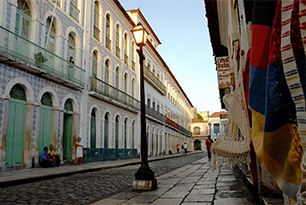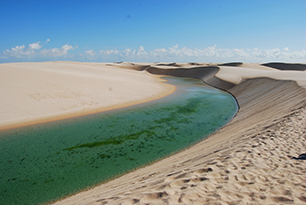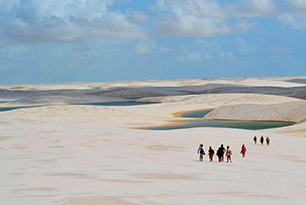How to get to São Luís:
There aren’t any international flights to São Luís, but you can find connections from almost every capital in Brazil from – TAM, Gol and Azul. The best option is Brasília, with more daily flights than both Rio de Janeiro and São Paulo.
To learn which companies flies to these cities, see the “about” section of each city or scroll down below to the "Learn More About Related Destinations".
Location:
São Luis is the capital and largest city of the Brazilian state of Maranhão in the northeastern of Brazil. The city is located on Ilha de São Luís (Saint Louis' Island) in the Baía de São Marcos (Saint Mark's Bay).
What to see:
In Sao Luís, the Centro Histórico (Historical Center) is the main attraction with an ensemble of over 3,500 colonial buildings from the 17th and 18th Centuries, distributed throughout the neighborhoods of Praia Grande, Desterro and Portinho, completely rehabilitated during the 1990s.
The city has many beaches along its 32 km of coastline. They lie beyond the São Francisco district, which is accessible through a bridge. The beaches become extremely crowded on sunny weekends. Swimmers should also remember that currents here are strong and the surf can be dangerous.
The city is split into 2 halves, one half is Bohemian, jazzy and traditional half, with old Portuguese buildings all over, complete with the famous outside tiling that you find all over some towns in Portugal.
The other half is a young, vibrant city, where you will find the best beaches, restaurants and discos.
The biggest attraction in the state is in the city of Barreirinhas: The famous Dunes of the “Lençóis Maranhenses”. The views are like something otherworldly. It’s like nothing you’ve seen! The Lençóis Maranhenses National Park is considered a rare geological formation on the planet, presenting a unique and very rich ecosystem. The dunes arrive from the coast entering in up to 15 miles of the coast.
You can reach the Lençóis Maranhenses through a transfer from the City of São Luís.
Climate and Temperature in São Luís:
Like many other northeastern capitals, warm throughout the year with rains during the winter. But São Luís is slightly hotter than Natal or João Pessoa.
The water temperature is around of 27 Degrees Celsius or 81 Degrees Fahrenheit. The temperature average throughout the year is of a maximum of 32 Degrees Celsius and the minimum slightly above 22 Degrees Celsius or 78 Fahrenheit.
Is slightly colder from May through August.
The rainy season is from February through May. In Lençóis Maranhenses, innumerable and limpid lagoons are formed with the rains of the rainy period. The months of August through December get the less rain.
Average Minimum and Maximum Temperature Over The Year In Celsius

Average Minimum and Maximum Temperature Over The Year In Fahrenheit

Average Monthly Precipitation Over the Year

The best time to go to São Luís:
Assuming you want good chances of getting sunny warm weather, the best time to go to São Luís are in the months of December, January, February and March.
What to try from São Luís' local cuisine:
Caldeirada de camarão: shrimp stew, is a delightful dish filled with big shrimps, vegetables, lemon, milk cream and coconut milk.
Arroz de Cuxá: it’s a Brazilian risotto, seasoned with a African spice called “vinagreira”, dry shrimp , usually served as a side dish for sea food.
General Information:
Local Time is UCT/GMT – 3.
Currency is the same all over Brazil - BRL – R$ - Brazilian Reais. Pronounced as Re-eyes (plural) or Re-owl (singular). No establishment accepts payment in any currency other than BRL.
Tap water is not drinkable. You should only drink bottled water. That is what you’ll be served when you ask for “water” anywhere you go.



